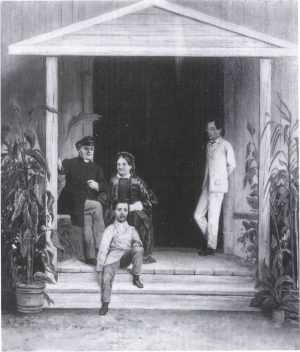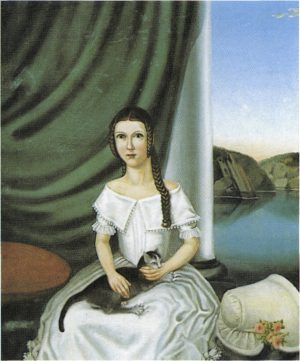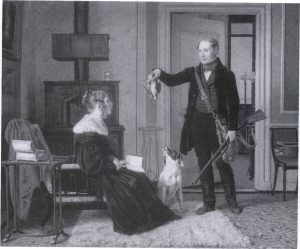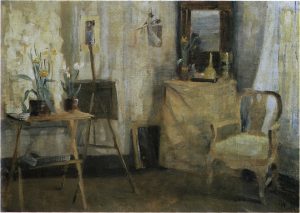Fredrika Runeberg (1807-1879) remarks in her memoirs, Min pennas saga (1946; The Story of my Pen), which was published together with Anteckningar om Runeberg (1946; Notes about Runeberg): “Most of my pieces have come into being, often written as well, when illness confined me to bed and I couldn’t sew, not even lying down. The majority of Fru Catharina Boije (1858; Lady Catharina Boije and her Daughters) originated in that manner. Much of it was thought out whilst sewing, whilst nursing children, whilst cooking, then hastily noted down on a Sunday evening, an afternoon when Runeberg tarried outside longer than usual, and the people in the house were asleep, or at other such opportune moments. A man writes when he wishes and is inspired to do so, a woman, at least one with children and a household, when she can and has time, happy and able at having been able to, as it were, purloin such a joy for herself. I must admit that I have often seen the colour fall from butterflies’ wings long before time allowed them to be fastened to paper. Oftentimes the length of a piece had to be adapted according to how long I had to write it down. But when my heart swelled in my breast, when my pulse raced violently, how the storm in my soul would not relent whensoever I had the chance to escape into the dreamy images of poetry, even if a long time passed before I allowed myself a moment to commit these often faded images to paper.”

A common observation is that Runeberg’s writing has been passed over for that of her husband, poet Johan Ludvig Runeberg (1804-1877), and that she had to accept his serial affairs with young women. He argued that such flings were vital ingredients of his creativity. He did not think that they had anything to do with his marriage, and his statement that she had been the best possible wife has gone down in the annals of history. Author Zacharias Topelius, a friend of the family, may have been alluding to his infidelities when he described her as a female martyr. Den frivilligt ödmjuka kvinnan (1979; The Voluntarily Humble Woman), Åsa Stenwall’s book about Runeberg, speaks of the same trait, whose aim was to save the friendship she had cultivated with her husband. But matters were no doubt more complicated than that.
The 28 May 1879 obituary of Fredrika Runeberg in the Helsinki daily Hufvudstadsbladet noted:
“Finland recognises her as her husband’s loyal companion in the ups and downs of life, its joys and its tribulations, and honours her as the ideal wife and mother.”
According to Min pennas saga, he coolly accepted her admiration without expressing the gratitude that she expected of him. Given the way their marriage had started out, that was not so surprising. Having grown up in a well-known family, she was intelligent and good at languages but troubled by her unattractiveness and lack of humour. One of her poems waxes ironic over the image that others seemed to have of her:
Tell me, was she a fair bridesmaid
in the blooming days of youth
fawned on by the multitudes?
Oh no, she was far from lovely.
She was a stately woman
attired in velvet and lace.
In the salon every night as a hostess?
No, but often at the bedside of her children.
Runeberg’s marital responsibilities included improving household finances, running a boarding house, taking care of seven children, and helping her husband edit the Swedish-language Helsinki newspaper Helsingfors Morgonblad.
Runeberg’s memoirs repeatedly emphasise that her husband encouraged her to write and stopped her from burning her works. Saying “this is excellent”, he urged her to send “Simrith” and “En dröm” (A Dream), her first two prose poems, to the editor of Joukahainen, a literary calendar. According to her, “[t]hat was one of the happiest moments my pen has afforded me.”
Robert Tengström, the editor of Joukahainen, was enthusiastic about the poems she submitted in 1842. After having read them to Zacharias Topelius and others, he wrote to her that he “was delighted to have discovered a new native poet.” Because Joukahainen only published contributions from members of the Österbotten Student Association, the poems were printed in 1843 by Necken, another literary yearbook.
The ambivalence inherent to Runeberg’s portrayal of her eternal humility and her husband’s generosity shines through in her description of his reaction when she showed him the edition of Necken:
“Once again I saw an expression on his face that kept me going for a long time.” He took the book, smiled, and requested “another glass for himself and the guests who were waiting in his private quarters so that they could celebrate the event together.” And “I was happy too as I sat there and rocked my baby.”
He was already a well-known author when they married, and he was ensconced as the national poet of Finland when her three works – her historical novels Fru Catharina Boije och hennes döttrar and Sigrid Liljeholm (1862; Sigrid Liljeholm), as well as her book of short stories Teckningar och drömmar (1861; Sketches and Dreams) – were brought out. His attitude to literature by women was benevolent but condescending. Zacharias Topelius and Johan Vilhelm Snellman, two other opinion-makers of the mid-nineteenth century, looked at matters similarly. Given that Fredrika Runeberg did not promote notions of women’s emancipation, they were all for her writing. Snellman’s review went out of the way to praise her for being modest and unassuming, as befitted her sex. His review of Fredrika Bremer’s Hertha in 1856, on the other hand, was disheartening; he argued that no man could love a woman as self-sufficient as the protagonist.

While dreaming about writing women’s history, Fredrika Runeberg deferred to the expectations of Snellman, Topelius, and her husband. She refrained from publishing her views on emancipation and waited fifteen years before bringing out her first novel. Her diaries and the pieces she composed at her kitchen table compared women’s status with slavery, and she felt that submission breeds duplicity. Her diary entries make it clear that she closely followed events in the 1840s when public schools for girls were first established in Finland, and in the 1860s when unmarried women were granted the right to manage their own incomes. Officially, however, she participated only in the work of organisations that carried on traditional charitable activities and supported schools for poor girls. Teckningar och drömmar contains only one story – “Facetter av qvinnans lif” (Facets of a Woman’s Life) – about the situation of women, particularly the fact that they weren’t entitled to practise a profession of their own. A group of women describe the difficulties they face: they can play the organ, make a scientific discovery, or lead a social movement, but only on the condition that they do so in the name of a male patron.
If Fru Catharina Boije och hennes döttrar had been brought out when it was written, it would have been the first Finnish historical novel. But Runeberg did not publish it until Topelius had popularised the new genre in the 1840s.
A common conceit was that reading novels had a pernicious influence on young women. Nevertheless, Fredrika Runeberg was allowed to partake of them. “Perhaps because I was never forbidden to read novels, they never held any kind of secret temptation for me. I never understood the double entendres that the books were supposed to contain. For the pure of heart, everything is pure. I read the novels as fairy-tales, as figments of the imagination with just as little claim of having a foothold in reality. Even as an adult, I was always frightened when a man was courteous or offered a compliment, fully convinced that I must have behaved improperly in one way or another.”
Historical novels did not give rise to any expectations at the time: fiction still had a bad reputation due to its capacity for entertainment. Johan Ludvig Runeberg tried to write a novel only once, and that was on a whim, though he published epics. Other than a couple of short poems, Fredrika Runeberg never concerned herself with the genres her husband worked in. The stories in Teckningar och drömmar are generally parables, a literary form that other female authors of the time took up. She called her novel Sigrid Liljeholm a “story” and was upset that the cover referred to it as a novel. She did not publish a single work under her own name; all of them used the pseudonym -a-g. As a counterweight to her unpretentiousness, she was careful not to let the tendency vulgarise her writing, and she grieved that many ideas withered on the vine due to lack of time. Topelius once suggested that she publish a book of short stories to promote women’s emancipation, but she rejected the offer. After Wilhelmina Carstens’s Murgrönan (1840; Ivy), the first Finnish novel by a woman, had been brought out, Runeberg wrote to one of her friends that some female authors resembled singers: those with talent are silent, while the most wretched ones crow away without being asked.
Runeberg wrote her first short stories in the 1830s after her husband had fallen in love with another woman, and her first novel took shape in the 1840s as his relationship with Emelie Björkstén began to unfold. The protagonist of the stories is generally a woman who holds onto her husband by helping him when he falls in love with a younger one, and ultimately accepts the new woman as a sister. Alhejdi, an innocent young woman in “Salik Sardar Khans maka” (Salik Sardar Khan’s Wife), is abducted by Prince Salik – a dangerous and exciting adventure for her, as well as the opportunity to be free of her father. It is not long before Salk brings home a young woman, whom Alhejdi protects (“I can’t be angry at you, my dove”). Her husband asserts his right to polygamy: “Salik picked up the rose and held it together with the lily. ‘Alhejdi, the heart of a man is like a rose garden, it has room for many flowers. How can you insist that I love only one forever? Love is also a flower; never demand of a flower that it be imperishable like stone, for that would rob it of its beauty. But you are also my beloved.’”
Salik dispatches Alhejdi on one difficult mission after another, finally to die for the sake of his favourite dog. Despite the patriarchal humiliations, she loves her husband (“But Alhejdi concealed her pain deep in her heart”) and even allies herself with his new conquest.
“Once when we stood in a room with yellow walls, he [Johan Ludvig Runeberg] said, ‘That a woman affirms and concedes what her husband has to say is of no importance, but she must think as he does. If he says that this yellow wall is black, it means nothing if she simply agrees with him, but she must believe that it actually is black.’
Oddly enough, our relationship almost became like that the longer we lived together, although I didn’t understand then that it could happen.” (Anteckningar om Runeberg)
A woman’s mad pride is her misfortune in “En saga om vreden” (A Tale of Anger). A man can give free rein to his fury, but not a woman: “You see, it nevertheless happens that many a poor woman notices the quiver when the springs are released. Horrified that the sharp weapons are on the loose, she wants to gather them back, but what can she do, the weak one, what does she understand, the ignorant one, of their strange mechanisms? She strains and musters every ounce of her strength and pushes them deep into her breast, harder, harder, they must be repressed, and finally, after she has struggled with them for an eternity, they wedge themselves into their assigned place and the vice clasps them once more; but her heart is shattered and grows sick before it heals. But her eye and tongue throw no more daggers, and at least she feels like a woman again.”

Runeberg writes that the history of women is mostly one of suffering, not of deed or action, since men have learned to rule and women to submit and control themselves. Associated with suffering, however, is the bittersweet pleasure of submission, often described in ironic terms.
Both of Runeberg’s novels present the utopia of a woman who runs her own life and, at least in that sense, behaves like a man. Margareta Boije, the heroine of the first novel, defies her mother, elopes with a commoner, and marries him on a frozen lake in the dark of night. She finds happiness, as opposed to her sister Cecilia, who stays at home, melts into the traditional woman’s role, and ultimately dies. The title character of Sigrid Liljeholm dresses up as a boy and rescues her father from captivity. When her fiancé leaves her because he does not think that such exploits are suitable for a decent woman, she forges a satisfying life for herself teaching and helping the local rural population. He subsequently repents, but she refuses to take him back: “Mr Enevald, I am no longer the young, pliable woman who lived to serve and bend to her husband’s will, to abandon herself and her own character and to dissolve in him. I was that way before, and still I have always, even then, believed that honour and conscience were a gift from God and hoped that I would be answerable to Him for their sake. Never have I thought that someone else would be responsible for my honour and righteousness, no more than I felt that I could or wanted to be responsible for theirs. Circumstances forced me at an early age to act on my own, guided only by what my conscience said I should do and venture. Now I have long been an independent woman, without anyone but God and my conscience to answer to, and I have lived as well as I knew how to. Too long have I lived selfishly to abandon myself and become a humble wife. Too long have I loved alone, too long felt that my honour and righteousness belonged only to me, to accept that they are not mine, but somebody else’s.”
Sigrid’s solution to the conflict women face resembles that of Fredrika Bremer’s Hertha in one respect, to work for the benefit of others, but is fundamentally different in that Hertha chooses both work and love, Sigrid only work. Runeberg had no understanding for the platonic companionate marriage between Hertha and Yngve; all of her heroines live for passion. Her 1859 story “Tre som flyttade till Sverige” (Three Who Moved to Sweden) spoke admiringly of Bremer, but she did not officially participate in the public discussion of Hertha. She took Bremer’s side in a letter to her sister, but maintained that the novel was about an unmarried woman’s limited ability to arrange her own life. In her view, Hertha stopped developing when she fell in love and was ensnared in the old patterns.
The dreams of allowing girls to grow up freely and of forging a new affinity with men are combined in “Rankvexten” (The Clinging Vine) from Teckningar och drömmar. The title reflects a common theme in nineteenth century women’s literature. The story traces the lushness and beauty of the vine as it acquires more light, knowledge, and freedom. The experiment succeeds even if the rest of the world is sceptical and scornful. “These trappings of power acquired so cunningly by the oppressed and so often exhibited by the other vines were no longer present, but – in all its beauty, opulence, and suppleness – my vine burst out in full, profuse, and fragrant flowers.”
One of Fredrika Runeberg’s letters argued that women should obtain knowledge and cultivation in order to more freely shape their relationships with men, while men should learn to appreciate women’s voluntary submission. Thus, the concept of more harmonious symbiosis is dependent on the basic ability and willingness of men to elevate the status of women.
Björkstén had originally planned to dedicate Drottningar (Queens), which contains twenty-four poems about ladies of royalty, to Fredrika Runeberg, according to Stenwall’s Den frivilligt ödmjuka kvinnan (1979; The Voluntarily Humble Woman), “But her cousin Richard Björkstén, the castellan at Stockholm Palace and apparently an ambitious gentlemen, persuaded her to dedicate it to Her Majesty Josefina, Queen Dowager of Sweden and Norway. That would surely attract publishers and more readers, and he was no doubt right.”
The other female authors in her husband’s circle had the same perspective on heterosexual relationships. Like Fredrika Runeberg, they were well-read and skilled at languages. At least one of them wrote for the same reason as her, to be appreciated by Johan Ludvig Runeberg, and they all showed their work first to him and then to her. Only Fredrika Runeberg published novel-length works, and even the titles of the poetry and short story collections by the other women writers are amateurish. Her sister-in-law Carolina Runeberg (1808-1891) named her book Små diktförsök (1855; Small Attempts at Poetry), and Fredrika Venman (1803-1873), the love of Johan Ludvig Runeberg’s youth, published Bleka blommor (1871; Pale Flowers). With the help of Runeberg samlingen (The J. L. Runeberg Collection), Björkstén (1823-1896) published Sandperlor af e*** (1864; Sand Pearls by e***), followed by a slim volume entitled Några Minnen af e*** (1871; A Few Memories by e***), which recalled (while Johan Ludvig Runeberg was still alive) how she had first become acquainted with him.
“Johan, don’t begrudge us, poor women, the pleasure of hearing a few warm and proud words every now and then. You know, a woman’s heart longs for them. We sit at our spinning wheel, our weaving or sewing, obscure feelings and thoughts swarm inside of us, and our poor hearts listen and listens but never hear the words that could decipher their secrets, for men cannot believe that we aspire to anything higher, because we never reveal that which dwells within us. So we listen and bide our time so long that all of these warm thoughts eventually ebb away.”
(Fru Catharina Boije och hennes döttrar)
In his circle, only unmarried women were supposed to write, which was no doubt one reason that his wife shied away from publishing her works. Carolina Runeberg and Wilhelmina Nordström (1815-1902) published only one book each and abandoned all literary pretensions when they became teachers. Johan Ludvig Runeberg printed a second edition of Nordström’s Dikter (1861; Poems) in 1864. By that time, Nordström was busy directing the private school for girls that she had founded. Augusta Lundahl (1811-1892), who was referred to as “learned” and a woman of “genius” because she was so widely read, published only in newspapers and yearbooks until giving it all up when she married.

The female authors found their subject matter in Johan Ludvig Runeberg’s nature poetry and his folk-song-like verse. However, they shied away from longer narrative poetry. One tendency they shared with each other, but not with their patron, was rich floral imagery. Women are compared to flowers in Fredrika Runeberg’s stories, and Sandperlor af e*** (1864; Sand Pearls by e***) contains a number of poems that use similar imagery to describe their lives. The metaphors of the imprisoned wave and the caged bird are also common. In Nordström’s and Björkstén’s poems, the metaphors refer both to women’s subjection at the hands of men and to their own inhibitions.
Nordström often contrasts hardness and softness, dependence and independence, freedom and captivity. Men are free, as in “Vildmarkens son” (Son of the Wilderness) and “Sjömansgossen” (The Sailor’s Boy), whereas women are imprisoned, as in “Fogeln i bur” (The Bird in the Cage):
Created by nature,
I for narrow cages,
I who have wings?
Please answer me.
Shall my light wing
Only an adornment be?
Tell me it is so!
I will be patient then.
In “Mossväxten” (The Moss Plant), the moss leans on the mountain, creeps caressingly along its side, softening and warming the earnest rock: “cheering with ease and calm delight / The hard rock’s solemn mien.” For the moss, this lot is “so comfortable, so sweet and glorious”, though not without irony. The clinging vine in Nordström’s “Lifvets stöd” (Life’s Support) also thrives and grows at great altitudes without effort: “Rising with simple pleasure / Higher with each faithful beat.”
Nordström’s poetry, which tends to be conventional and congenially religious, contains frequent references to an unknown realm of her own mind and to a streak of violence. The lake in “En vind” (A Wind) trembles such that the narrator no longer recognises its “calm and cool” surface. The waves destroy the flowers on the shore and the “world of blossom” that the lake just kissed. The wave in “Vid musslans hjerta” (At the Oyster’s Heart) steals the pearl by force because he thinks it belongs to him: “And the ocean wave, so sweetly blue, / Quickly claimed his own / In his ruthless way.”
The lover in “Hon trängde sig till mitt hjerta” (She Forced Her Way into My Heart) seeks protection in the narrator’s breast: “She wanted to rest there; / She thought that life’s pain / Would stop forever.” But “my heart, the wild one” crushes anything that is soft “with hard and powerful blows”. Counterbalancing all this violence is a kind of intangibility, a dreamlike love in “Utan ljud och ton” (Without Sound or Tone), and the beloved (always a woman in Nordström’s poetry) resembles an angel:
She put her delicate hand in mine,
Leaned her head lightly
on my shoulder and said not a word;
In her silent way,
She whispered soft and tender feelings
To my heart,
Sweetly as angels whisper, when we dream
without sound or tone.
Sweetly, as angels whisper, when we dream
without sound or tone.
Björkstén’s poems also combine conventional patriotism with a deep emotional conflict. Her relationship with Johan Ludvig Runeberg was accepted only because his wife appeared to have sanctioned it. The two women were friends for decades; they wrote to each other frequently, and Björkstén expressed a recurring desire to escape from her lover. She dedicated Ännu en gång (1877; One More Time) to her friend. Writing brought them together, and they both admired Johan Ludvig Runeberg, primarily as an author. Björkstén prays: “Light, tones, love, I want to forsake it all / Oh ye gods, give me but the power to create”, “For inexhaustible power to create I pray.” But her attitude to love is ambivalent. On one hand, the beloved is everything:
Only you.
You alone among everyone.
You do I want to love, only you.
Oh, let the world call me just one more fool,
Does it understand the wellbeing of my soul,
Can it look into the depths of my heart?
On the other hand, love is a shackle that prevents her from pursuing her own calling, “If only I were free!” The narrator of “Hvad jag älskar” (What I Love) takes an inventory, mentioning poetry last and most importantly. “The best thing heaven bequeathed us / To delight the heart is poetry!” Björkstén lived her whole life, from adolescence until old age, for Johan Ludvig Runeberg. He was her literary idol as well, but she also possessed the longing and ambition to create something of her own.
Translated by Ken Schubert

